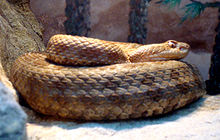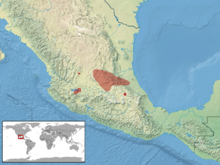Querétaro dusky rattlesnake
| Querétaro dusky rattlesnake | |
|---|---|

| |
| Scientific classification | |
| Domain: | Eukaryota |
| Kingdom: | Animalia |
| Phylum: | Chordata |
| Class: | Reptilia |
| Order: | Squamata |
| Suborder: | Serpentes |
| Family: | Viperidae |
| Genus: | Crotalus |
| Species: | C. aquilus
|
| Binomial name | |
| Crotalus aquilus Klauber, 1952
| |

| |
| Synonyms | |
| |
The Querètaro Dusky Rattlesnake (Crotalus Aquilus) also known as the "Vibora de cascabel", is a species of venomous Pit viper found usually on highlands of central Mexico. The scientific name "Aquilus" is a Latin word meaning "eagle", referring to the highlands on which it lives on. They are not a very well known species of rattlesnake, but the people in Mexico know much about them.
Description
[change | change source]Adult Querètaro Dusky Rattlesnakes are around 50 centimeters (20 in) in length, but some can be as long as 67.8 centimeters (26.7 in). They are usually green, yellow, dark gray, or dark brown in color, with dark brown or black blotches on them.
Where they live
[change | change source]They live mainly on highlands of central Mexico, but they also live in pine-oak forests, grasslands and grassy hills and mountains. The states of Mexico of which they live in are Querétaro,Guanajuato, Hidalgo, México, Michoacán and San Luis Potosí.
Feeding
[change | change source]The Querètaro Dusky Rattlesnake eats mainly lizards, but they also eat frogs and many different types of rodents. Young ones also eat insects.
Venom
[change | change source]This rattlesnake is a type of venomous Pit viper, and one bite of it can harm a human. The poison of the Querètaro Dusky Rattlesnake is hemotoxic, meaning the poison affects the blood of a humans body. However the Querètaro Dusky Rattlesnake does not bite many people because it likes to be left alone; it will only bite a person if the person attacks it or annoys it.

